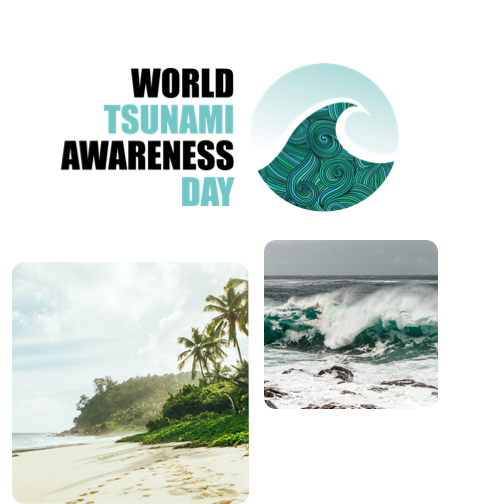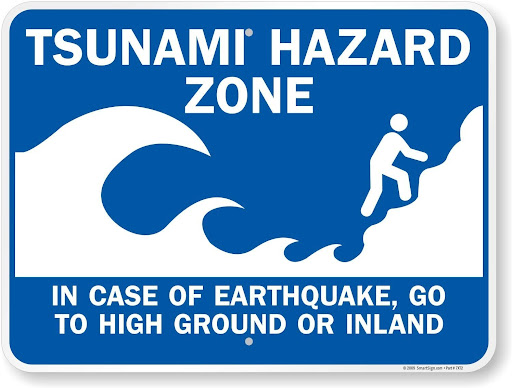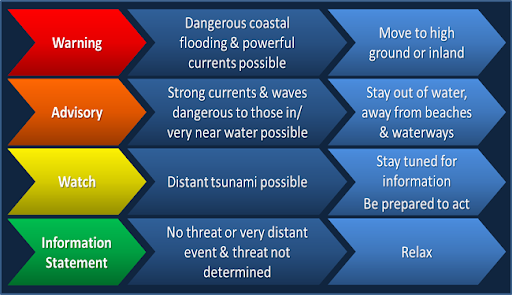 Imagine this: you are sitting on a beautiful beach enjoying a lovely day, when out of the blue an alarm blasts from your phone and reads “Tsunami warning.” Do you know where you would go and what to do? What if you aren’t in the U.S. and there are no alarms, would you know the signs of an approaching tsunami?
Imagine this: you are sitting on a beautiful beach enjoying a lovely day, when out of the blue an alarm blasts from your phone and reads “Tsunami warning.” Do you know where you would go and what to do? What if you aren’t in the U.S. and there are no alarms, would you know the signs of an approaching tsunami?
Tsunamis are the stuff of nightmares! While they don’t occur very often, when they do they can be devastating and deadly. Have you thought about the actions you can take immediately after an alert is received to ensure the safety of yourself and others? Is your coastal town TsunamiReady® and taking the threat of a tsunami into consideration for coastal development and planning? Nov. 5 was World Tsunami Awareness Day and we in the Disaster Preparedness Program believe that preparedness begins with knowledge and understanding.
What exactly is a tsunami? A tsunami is a series of long period ocean waves that can cause severe flooding and unusually strong currents created by a large and sudden displacement of the ocean, most often caused by an earthquake.
What are the natural signs of an approaching tsunami? Depending on where you are located and the source of the tsunami, the following are natural signs that could indicate an approaching tsunami:
- A long earthquake lasting 20-seconds or more.
- A very strong earthquake that knocks you off your feet.
- A rapid, unusual rise or fall in the water level.
- A loud roar from the ocean
How do I know the risk of a tsunami?
 Tsunami expert, Dr. Walter Dudley, in a recent lecture on our You Don't Know What You Don't Know Lecture Series, reminded us that a tsunami can happen on any coast! However, they are more likely to occur in the Pacific and in the Caribbean. There are a few ways to know if the area you live, work or are vacationing at is at risk of a tsunami.
Tsunami expert, Dr. Walter Dudley, in a recent lecture on our You Don't Know What You Don't Know Lecture Series, reminded us that a tsunami can happen on any coast! However, they are more likely to occur in the Pacific and in the Caribbean. There are a few ways to know if the area you live, work or are vacationing at is at risk of a tsunami.
- Notice the signs! NOAA, in partnership with local and state governments as part of the National Tsunami Hazard Mitigation Program, has adopted signs that indicate when you are entering a Tsunami Hazard Zone and also along tsunami evacuation routes.
- Map it! Depending on your location there are detailed maps indicating the tsunami hazard zone.
- Know the risk of earthquake activity and location of seismic gaps. Earthquakes are not predictable. However, scientists continually seek to better understand the probability of an earthquake occurring. Seismic gaps are areas that typically experience earthquake/ seismic activity, but have not in a long period of time. Therefore, there is potential that stored stress will at some point slip, producing a large earthquake. Scientists look for areas that have seismic gaps in order to determine potential risk of large earthquakes that could result in tsunamis.
Is someone watching for potential tsunamis?
Yes! NOAA’s Tsunami program has you covered! NOAA operates two Tsunami Warning Centers that monitor for tsunamis and earthquakes that may cause them around the clock. They also forecast tsunami impacts and issue tsunami messages and warnings. The two warning centers serve the continental United States, Alaska, Canada, the Hawaiian Islands, the U.S. Pacific and Caribbean territories, and the British Virgin Islands. NOAA also works internationally with the United Nations to provide detection and threat advice across the globe.

What do I do when an alarm sounds or I see signs of a possible tsunami?
If you are in a hazard zone and you feel a long, strong earthquake (one that lasts for 20 seconds or more) and/or receive a tsunami warning, it is important to:
- Remain Calm.
- If there is an earthquake, drop, cover, and hold on during the earthquake.
- Quickly walk or run to higher ground (100’ above sea level) or inland (1 mile) outside of the Tsunami Hazard Zone.
- If you are not able to move that distance, move to the fourth floor or higher in a sturdy building.
- Once you are in a secure place, do not return to the coastal zone until after you get an all clear message from authorities. Tsunami waves can continue for hours. The first wave may not be the largest.
How do I prepare for a tsunami?
Many people live, work, or go to school in a tsunami hazard zone. If you do, it is important to identify where your closest safezone is and plan out the quickest, walkable route there. Once you have a plan, practice it! One way to do this is by conducting a Tsunami Walk. A tsunami walk is a drill in which participants walk their evacuation route and compare the time it takes to the potential arrival time of tsunami waves. If safety zones are not accessible, talk with your local officials. Make sure your community is TsunamiReady®.
Learn from survivors
Because tsunamis don’t happen frequently, it is important to keep the stories of survivors and the history of tsunami events alive. This reminds us of the very real impact tsunamis can have on ordinary lives. Places like the Pacific Tsunami Museum in Hilo, Hawaii have taken great effort to record the oral history of tsunami survivors. The United Nations has also worked to record videos of survivor accounts from across the globe. The Alaska Department of Homeland Security has recorded stories from the 1964 earthquake and tsunami survivors. Even some of our NOAA colleagues, like Dwayne Meadows, are tsunami survivors. It is worthwhile to take time to read or watch accounts like Dwayne’s. They are not only touching, they also bring to life what seems unimaginable. No one wants to imagine a life altering disaster, but lives can be saved if we prepare. Take action and get prepared!
Tsunami References and Resources:
- NOAA’s Tsunami Program: https://tsunami.gov
- NOAA’s Tsunami Ready Program: https://www.weather.gov/
tsunamiready/ - NOAA’s Center for Tsunami Research: https://nctr.pmel.noaa.gov/
index.html - NOAA’s National Center For Environmental Information, Tsunami Data and Information: https://www.ngdc.noaa.gov/
hazard/tsu.shtml - Ocean Today Tsunami Awareness Film: https://oceantoday.noaa.gov/
tsunamiawareness/ - The National Tsunami Hazard Mitigation Program: https://nws.weather.gov/nthmp/
about_program.html - FEMA’s Ready Program: https://www.ready.gov/tsunamis
- The Tsunami Zone: https://www.tsunamizone.org/
- International Tsunami Information Center: http://itic.ioc-unesco.org/
index.php - UN Tsunami Day: https://tsunamiday.undrr.org/
